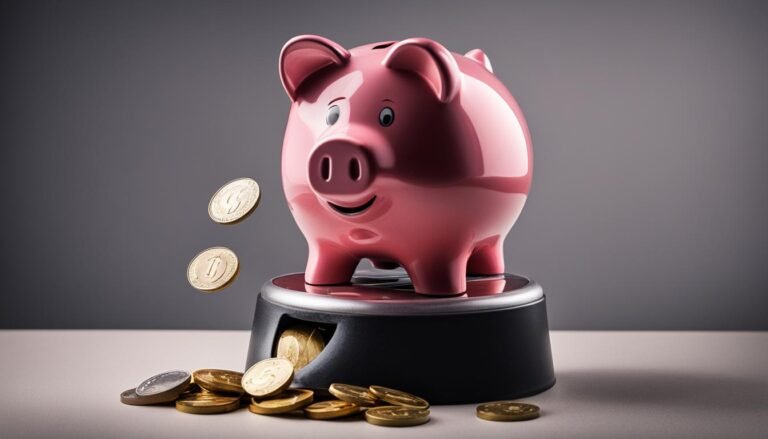Maximizing Benefits with Credit Card Usage
Are you making the most of your credit card? When used wisely, credit cards can offer a range of benefits, from earning rewards on everyday spending to accessing valuable perks and discounts. In this article, we’ll explore some tips to help you maximize the benefits of your credit card usage and make smart financial decisions.
Key Takeaways:
- Choose a credit card that aligns with your spending habits to maximize rewards
- Optimize rewards categories by using different cards for different spending categories
- Earn sign-up bonuses by meeting spending requirements
- Explore different redemption options for your accumulated rewards
- Take advantage of card perks and benefits
Matching your Rewards Structure to Your Spending Habits
To maximize the rewards from your credit card, it’s important to choose a card that aligns with your spending habits. Different rewards credit cards offer various rewards structures, such as boosted points, miles, or cash back on specific categories like travel, groceries, or gas. By identifying where you spend the most money and selecting a card that offers higher earning potential in those categories, you can make the most of your credit card rewards.
When considering which rewards credit card to choose, take into account your spending habits and the categories in which you make the most purchases. If you frequently travel, a card that offers extra points or miles on travel-related expenses could be the best fit for you. On the other hand, if you find yourself spending a significant amount on groceries or gas, a card that provides higher cash back in those categories may be more beneficial.
“Choosing a rewards credit card that matches your spending habits allows you to earn more rewards in the areas where you naturally spend the most. It’s a strategic way to optimize your credit card usage and maximize your earning potential.”
By aligning your credit card rewards structure with your personal spending habits, you can unlock the earning potential of your credit card. This strategic approach ensures that you receive the most value from your everyday purchases and ultimately reap the benefits that rewards credit cards have to offer.
Benefits of Matching Rewards Structure with Spending Habits
| Spending Habits | Recommended Rewards Card | Earning Potential |
|---|---|---|
| Travel | Airline or travel rewards credit card | Extra points/miles on flights, hotels, and travel expenses |
| Groceries | Cash back credit card with boosted rewards for supermarket purchases | Higher cash back on grocery expenses |
| Gas | Cash back credit card with additional rewards on fuel purchases | Increased cash back on gas expenditures |
Optimizing Rewards Categories
When it comes to maximizing your credit card rewards, taking advantage of bonus categories is key. Many credit cards offer rotating bonus categories that provide higher cash back rewards for specific periods. By regularly checking and activating these categories, you can make the most of your rewards.
But that’s not all. Another effective strategy for maximizing rewards is strategically using different credit cards for different spending categories. By using a card that offers higher cash back at supermarkets for your grocery purchases, and another card for dining out to earn more rewards in those categories, you can further enhance your rewards potential.
Let’s take a closer look at how you can optimize your rewards categories to make the most of your credit card rewards:
1. Take Advantage of Rotating Bonus Categories
Many credit card companies offer bonus categories that change on a quarterly or monthly basis. These categories often include popular spending areas such as groceries, gas stations, dining, and online shopping. By familiarizing yourself with your credit cards’ bonus categories, you can ensure you are earning the highest possible rewards on your everyday purchases.
To stay informed about these rotating categories, check your credit card issuer’s website or mobile app regularly. You can also sign up for email or text alerts to be notified when new bonus categories are introduced. Make it a habit to activate these bonus categories as soon as they become available to maximize your rewards earning potential.
2. Strategically Distribute Your Spending
Using different credit cards for different spending categories can help you maximize your rewards. By choosing cards that offer enhanced cash back or rewards in specific areas, you can earn more for every dollar you spend.
For example, if you frequently shop at supermarkets, using a credit card that offers higher cash back or rewards on grocery purchases can help you earn more in that category. Likewise, if you dine out frequently, using a card that offers bonus rewards for dining can help you make the most of your restaurant expenses.
It’s important to keep in mind any annual fees associated with these cards and ensure the benefits outweigh the costs.
3. Consider Complementary Cards
If you have multiple credit cards, consider using them in tandem to maximize your rewards potential. By using cards that complement each other’s bonus categories, you can earn rewards on a wider range of spending.
For example, if you have a cash back card that offers higher rewards on gas and groceries, and another card that offers boosted rewards on travel and dining, you can strategically use the appropriate card for each category to earn the most rewards possible.
Remember to keep track of your spending and make timely payments to avoid accruing interest or carrying a balance.
By optimizing your credit card rewards categories, you can make the most of your spending and earn valuable cash back or rewards. Whether it’s taking advantage of rotating bonus categories or strategically using different cards for specific spending areas, maximizing your rewards potential is within reach.
Earning Sign-Up Bonuses
Credit cards offer more than just convenient payment options. They often come with enticing sign-up bonuses that can help you earn valuable rewards. By taking advantage of these bonuses, you can enjoy significant benefits while meeting your spending requirements.
Sign-up bonuses are typically awarded when you apply for a new credit card and successfully meet certain spending requirements within a specific timeframe. These bonuses can range from cash back to travel rewards, and they provide a great opportunity to maximize the value of your credit card’s rewards program.
To earn a sign-up bonus, you’ll typically need to spend a specific amount of money within a certain period. It’s important to carefully review the terms and conditions associated with each bonus offer to ensure that you meet the requirements. By structuring your spending accordingly, you can easily meet the necessary spending threshold and unlock the rewards.
Remember to track your spending and stay organized to ensure you don’t miss out on earning your sign-up bonus. Regularly monitoring your progress towards meeting the requirements will help you stay on track and make the most of these valuable offers.
Here’s an example of how a credit card sign-up bonus can work:
| Card | Sign-Up Bonus | Spending Requirement | Timeframe |
|---|---|---|---|
| Credit Card XYZ | $500 cash back | Spend $3,000 | Within the first 90 days |
By spending $3,000 on purchases within the first 90 days of opening your Credit Card XYZ account, you can earn a sign-up bonus of $500 cash back.
Earning a credit card sign-up bonus is a smart way to kick-start your rewards journey. It’s important to choose a card with a sign-up bonus that aligns with your spending habits and financial goals. That way, you can optimize your rewards and make the most of your everyday purchases.
Next, we’ll explore different redemption options for your credit card rewards and how to determine the most valuable way to use them.
Exploring Redemption Options
Once you’ve accumulated credit card rewards, the next step is to explore the various redemption options available to make the most of your earnings. By understanding the different ways you can redeem your rewards, you can choose the option that provides the greatest value for you.
You have several options when it comes to redemption, including:
- Statement Credits: Use your rewards to offset your credit card balance, reducing the amount you owe.
- Direct Deposits: Transfer your rewards directly into your bank account, giving you cash back to use as you please.
- Gift Cards: Exchange your rewards for gift cards to your favorite stores or restaurants.
- Merchandise: Redeem your rewards for a wide range of merchandise, from electronics to home goods.
- Travel Bookings: Use your rewards to book flights, hotels, or rental cars for your next vacation.
Tip: Keep in mind that the value you get from your rewards can vary depending on the redemption option you choose. Before redeeming, compare the value of each option to ensure you’re getting the most out of your rewards.
If you’re interested in travel rewards, you may have additional ways to maximize the value of your points or miles. Some credit cards allow you to transfer your rewards to partner airlines or hotels, providing opportunities for even greater value when booking flights or accommodations.
Table: Comparison of Different Redemption Options
| Redemption Option | Pros | Cons |
|---|---|---|
| Statement Credits | Flexibility to use rewards for any purchase | May not provide the highest redemption value |
| Direct Deposits | Immediate access to cash | May require a minimum redemption threshold |
| Gift Cards | Wide range of options available | Some gift cards may have restrictions or expiration dates |
| Merchandise | Opportunity to choose from various products | May have a lower redemption value compared to other options |
| Travel Bookings | Potential for high value when booking flights or hotels | Redemption options may be limited to specific partners |
By carefully evaluating the redemption options and considering your personal preferences and goals, you can make informed decisions to make the most of your credit card rewards. Whether you prefer the flexibility of statement credits, the convenience of direct deposits, or the thrill of redeeming for travel, the choice is yours.
Utilizing Card Perks
In addition to earning rewards, your credit card may offer a range of enticing perks and benefits. These perks can enhance the overall value of your credit card usage, providing you with added advantages and savings. Some of the common perks offered by credit cards include:
- Airport Lounge Access: Gain access to exclusive airport lounges where you can relax, enjoy complimentary refreshments, and access business facilities before your flight.
- Hotel Credits: Receive credits towards hotel stays, upgrades, or amenities, allowing you to enjoy a more luxurious experience while paying less.
- Travel Insurance: Benefit from travel insurance coverage that protects you against unforeseen circumstances such as trip cancellation, lost luggage, or medical emergencies.
- Extended Warranties: Extend the warranty period on eligible purchases, giving you added peace of mind and protection against defects or malfunctions.
- Shopping Discounts: Enjoy exclusive discounts or cashback offers when shopping at select retailers, both online and in-store.
Make the Most of your Card Perks
To fully utilize these card perks, it’s important to understand the terms and conditions associated with each benefit. Some perks may require activation or enrollment, while others may have specific eligibility criteria. Take the time to review your credit card’s perks and familiarize yourself with the available benefits. Here are some tips to help you maximize your card perks:
“Take advantage of exclusive airport lounges, extended warranties, and shopping discounts to enhance the value of your credit card usage.”
- Know your perks: Read the fine print and understand the benefits your credit card offers. Identify the ones that align with your lifestyle and needs.
- Utilize airport lounges: Before your next trip, take advantage of airport lounge access and enjoy a comfortable and luxurious pre-flight experience.
- Redeem hotel credits: Make use of your hotel credits to upgrade your accommodations or enjoy additional amenities during your travels.
- Understand travel insurance: Familiarize yourself with the coverage provided by your credit card’s travel insurance to ensure you’re adequately protected during your trips.
- Take advantage of extended warranties: Register your eligible purchases and take advantage of extended warranty coverage for added peace of mind.
- Shop smart: Keep an eye out for discounts and cashback offers when shopping at partner retailers. Take advantage of these savings to stretch your budget further.
By utilizing the perks offered by your credit card, you can enhance your overall experience, save money, and make the most of your credit card usage.
Take advantage of credit card perks to enhance your travel, enjoy added benefits, and save money.
Paying Your Bill on Time
The most important principle of credit card usage is to pay your bill on time every month. Late payments can result in high interest charges, late fees, and negative impacts on your credit score. By making on-time payments, you can avoid these penalties and maintain a healthy financial status.
“Paying your bill on time is crucial to avoid unnecessary charges and maintain a good credit score.”
When you pay your credit card bill on time, you demonstrate responsible financial behavior and reduce the risk of accruing interest charges. On-time payments ensure that you’re not carrying a balance from month to month, which can save you a considerable amount in interest fees over time.
To help you stay organized and ensure timely payments, consider setting up automatic payments through your credit card provider or your banking institution. Automatic payments can save you from the risk of forgetting to pay your bill and incurring fees or interest charges. Remember to keep track of your credit card payments, so you can monitor your expenses and maintain a budget that includes paying off your balance in full each month.
Benefits of On-Time Payment:
- Avoiding interest charges on your credit card balance
- Avoiding late fees and penalties
- Maintaining a positive credit history and improving your credit score
- Qualifying for better credit card offers and rewards programs in the future
By making on-time payments, you can establish a good credit history, which is crucial when applying for loans, mortgages, or other forms of credit in the future. Your creditworthiness will be assessed by lenders, and a history of on-time payments will demonstrate your ability to manage credit responsibly.
Remember, consistently paying your credit card bill on time is a key factor in avoiding unnecessary charges and building a strong financial foundation. Take control of your finances by making on-time payments and enjoy the benefits of responsible credit card usage.
Keeping Your Balance Low
When it comes to responsible credit card usage, one of the key factors to consider is keeping your credit card balance low relative to your credit limit. Not only does this practice help improve your credit score, but it also makes it easier for you to pay off your balance in full.
Maintaining a low credit card balance demonstrates your responsible financial management and prevents you from carrying unnecessary debt. It shows lenders and credit bureaus that you are utilizing your credit responsibly and can handle your financial obligations effectively.
Additionally, a low credit card balance plays a vital role in your credit utilization ratio. This ratio, which compares your outstanding balances to your total credit limits, is a crucial factor in determining your creditworthiness. By maintaining a low balance, you keep your credit utilization ratio low, which generally reflects positively on your credit profile.
To illustrate the importance of keeping your balance low, consider the following example:
Imagine you have a credit card with a $5,000 credit limit. If you consistently carry a balance of $4,000 on that card, your credit utilization ratio is at a high 80%. This high ratio can raise concerns among lenders and negatively impact your credit score. However, if you can keep your balance around $500, your credit utilization ratio drops to a more favorable 10%.
By maintaining a low balance, you also reduce the risk of accumulating interest charges on your credit card debt. Most credit cards have high interest rates, and carrying a balance can quickly lead to mounting interest charges, which add to your financial burden. By paying off your balance in full each month, you avoid these charges and save money in the long run.
Remember, responsible credit card usage involves not only making on-time payments but also keeping your credit card balance low. By practicing this habit, you demonstrate financial discipline, improve your creditworthiness, and avoid unnecessary debt.
| Benefits of Maintaining a Low Credit Card Balance |
|---|
| Improved credit score |
| Lower credit utilization ratio |
| Reduced risk of accumulating interest charges |
| Less financial burden |
Understanding Interest Calculation
To make the most of your credit card usage, it’s crucial to understand how credit card interest is calculated. By doing so, you can avoid unnecessary charges and save money. Most credit card issuers determine interest charges based on two key factors: your average daily balance and your card’s annual percentage rate (APR).
Firstly, your average daily balance refers to the average amount of money you owe on your credit card over a given billing cycle. This balance includes any new purchases, balance transfers, or cash advances, but excludes any payments or credits received during that period. The higher your average daily balance, the more interest you will be charged.
Secondly, the APR is the annual interest rate charged by the credit card company. This percentage is applied to your outstanding balance to calculate the interest you owe. It’s important to note that credit card APRs are often higher than other types of loans or financing, making it crucial to pay attention to your balance and payment habits.
To avoid paying interest charges on your credit card, it’s advisable to pay your balance in full each month. By doing so, you demonstrate responsible financial management and avoid carrying any debt from one month to another. Paying in full means that you are not carrying a balance from the previous billing cycle, which eliminates the need for interest charges.
While paying in full may not always be possible for everyone, it’s still essential to pay more than just the minimum payment required. By paying more than the minimum, you can reduce your average daily balance and minimize the interest you owe. Even paying a little more each month can make a significant difference in the long run.
Remember, paying in full not only helps you avoid interest charges but also allows you to make the most of your credit card rewards. By utilizing your credit card for everyday purchases and paying the balance in full, you can earn rewards without paying any additional costs in interest.
Understanding how credit card interest is calculated empowers you to make informed financial decisions and avoid unnecessary charges. By paying your balance in full each month, or at least more than the minimum payment, you can enjoy the benefits of your credit card without incurring interest expenses.
“Paying your credit card balance in full each month is one of the most effective ways to avoid interest charges and keep your finances in check.”
Example: Calculating Interest
| Balance | APR | Interest Charged |
|---|---|---|
| $1,000 | 20% | $16.67 |
| $2,500 | 15% | $31.25 |
| $5,000 | 10% | $41.67 |
Note: The interest charged is calculated based on a billing cycle of 30 days.
Conclusion
To maximize the benefits of credit card usage, it’s crucial to practice responsible financial management. By aligning your rewards structure with your spending habits, optimizing rewards categories, and earning sign-up bonuses, you can make the most of your credit cards and enhance your financial well-being.
Exploring redemption options and utilizing card perks further add value to your credit card usage, providing you with additional opportunities to maximize benefits. Remember to pay your bill on time, keeping your balance low to avoid unnecessary interest charges and maintain a healthy credit utilization ratio.
Understanding how interest is calculated and paying your balance in full each month will help you avoid additional charges and save money. By practicing responsible credit card usage, you can harness the full potential of your credit cards and enjoy the rewards they offer.







